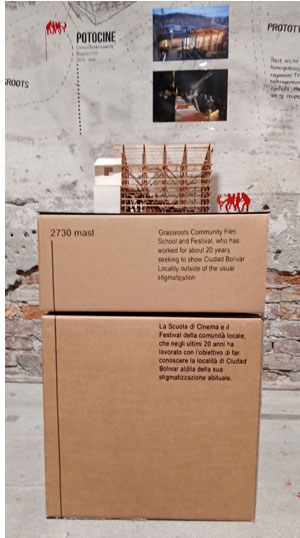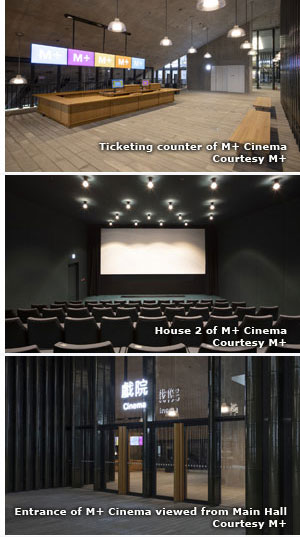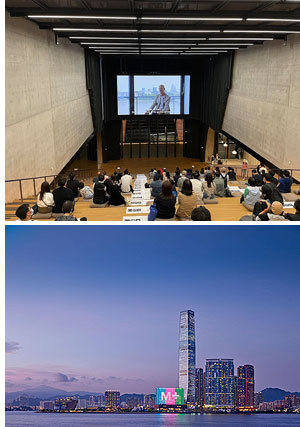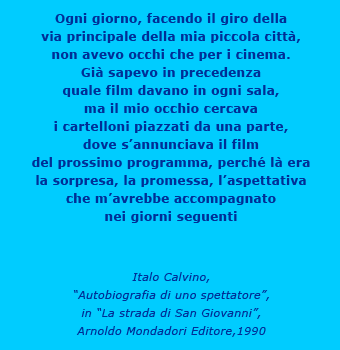Dear Readers,

 we return to the subject of the close links between the cinema, art and architecture. we return to the subject of the close links between the cinema, art and architecture.
From a “micro” as well as a “maxi” perspective.
And we do so by presenting a “self-built” theatre in Colombia chosen by the latest Biennale of Architecture for its ability to stimulate alternative forms of participation.
And also by outlining the great, innovative M+ in Hong Kong, which includes three movie theatres.
Two different ways of offering the magic of the big screen but which encourage us to reflect on the social role that the cinema - the authentic kind, together at the theatre - continues to play.
Lastly, this new issue inaugurates the new “cinema chart” which, thanks to a simple click, makes it possible to see the main cinema chains in Europe and where they operate.
Happy reading!
Elisabetta Brunella
Secretary General of MEDIA Salles |
|
|
|
Which space to cinemas at the 17th International Architecture Exhibition in Venice? - part 2
|
|
Potocine - This space is yours and ours: we have to look after it!
by Elisabetta Brunella

 We have already mentioned this in the presentation of the Kino Armata in Prishtina, capital of Kosovo: the latest Venice Biennale of Architecture highlighted the styles and modes of “community” life, choosing the theme: "How will we live together?", yet not a lot of movie theatres have been featured in the exhibition, extraordinary as it is. Not a lot, but definitely significant ones: this time the subject is Potocine, a structure founded according to the spirit of: “So there’s no cinema in our district? Right, let’s build one!" We have already mentioned this in the presentation of the Kino Armata in Prishtina, capital of Kosovo: the latest Venice Biennale of Architecture highlighted the styles and modes of “community” life, choosing the theme: "How will we live together?", yet not a lot of movie theatres have been featured in the exhibition, extraordinary as it is. Not a lot, but definitely significant ones: this time the subject is Potocine, a structure founded according to the spirit of: “So there’s no cinema in our district? Right, let’s build one!"
Potocine is, in fact, a self-built and self-managed project which has allowed the inhabitants of Ciudad Bolívar, a densely populated suburb of Bogotá, to benefit from the first non-commercial movie theatre.
More specifically, the structure is situated in the close-knit urban fabric of Potosí,a hillside district between the edge of the city and the first stretch of countryside, south-west of Colombia’s capital. It came into being in the ‘Eighties and consists mostly of illegal buildings which do not benefit from town planning and public services such as recreational areas.
Nonetheless, in only a short time it has attracted a great many inhabitants, who have moved from areas affected by the guerrilla warfare or for socio-economic reasons.
Still today Potosí suffers from serious problems linked to illegal mining activities, drug dealing and violence both inside and outside the family. In order to contrast this social decay with a cultural and educational intervention, in the mid-Eighties a non-governmental initiative came into being, agreed on with an assembly of inhabitants. Within this framework a school for cinema and audiovisual production was set up, called "Ojo al Sancocho", which now boasts more than ten years of activity and has become a tool for vehicling the awareness of social rights and assumption of responsibility.
From this initiative, in 2008 a festival arose and later the aim of having a real movie theatre - not only in relation to the other activities but as an outpost, the symbol of a new way of taking part in community life and a tool for vehicling a more positive image of Potosí.
The project succeeded in taking off thanks to the purchase of a lot of land on which two small buildings were situated. One was conserved as the centre for audio visual production, whilst the other was demolished to make way for the building of a real movie theatre.
The self-building process took on a decidedly political significance: it was based on an exchange of knowledge and competences and on the use of local materials. A special variety of Colombian bamboo (gradua) was selected for completing the structure and purposely left visible thanks to the use of the transparent alveolar polycarbonate coating material.
Bamboo was also used to make the seats, conceived as extensions of the steps and completed with fabric covers sewn by the women of the community, like beach loungers.
Built in a record time of 4 months and situated 2,730 metres above sea level, the cinema came into being in 2016. The spirit that led to its construction is summed up in the words painted on the outer wall: “This space is yours and ours: we have to look after it!”

|
|
|
ART AND CINEMAS |
 M+: very cinematographic M+: very cinematographic
by Elisabetta Brunella

"Universal and open" says Jacques Herzog about "his" museum in Hong Kong.
I would add cinematographic, very cinematographic.
For many reasons. In fact M+ not only hosts the visual arts of the new millennium, in movement and digital, like the seventh art a century after the Lumières (or the Skladanowskys), but its conception and realisation, too, were followed from the very first by the eye of the movie camera. And even before it saw the light of day at the end of 2021 - with a few years’ delay on its schedule - this revolutionary building was already doing the rounds of the festivals thanks to the short film "Building M+".
The shape of it is even more cinematographic: basically M+ is an enormous screen, overlooking the bay of Hong Kong and clearly visible day and night to thousands of citizens and tourists. A LED screen, i.e. a foretaste of what we shall find in real cinemas when technological progress and lower costs, which are still prohibitive nowadays, will put an end to the projector.
And, last but not least, M+ is cinematographic because, as well as all the rest - see Virginia Fanin’s article - it is also a cinema. In this great and neutral container for works of art, “warmed up" by materials like wood and the ceramics of the ancient tradition, three screens are housed, elegantly furnished with FRAU armchair seats made in Italy and enlivened by the colours ranging from blue to purple to green of fabrics by the Danish firm Kvadra.
Fitted with cutting-edge technology, including 4K projectors, they have been conceived to offer a mix of fiction and documentaries, heritage films and experimental material, video art and works functional to the Museum’s exhibition programme.
There is no lack of content linked to the evolution of Asian society. Again with a view to making M+ a place for exchanges between Asia and the rest of the world, as between today, yesterday and tomorrow.
A single doubt remains: when will the anti-Covid restrictions be lifted so that it will finally be possible to fully enjoy the M+? |
|
|
Far more than a Museum
by Virginia Fanin

M+ is one of the world’s largest Museums of modern and contemporary art and visual culture, situated in the cultural district of West Kowloon, Hong Kong.
 Suhanya Raffell, Director of the Museum, explains that the choice of name is due to the fact that the combination of digital, works of art, technology and material objects has brought to life something that is much more than a museum. Suhanya Raffell, Director of the Museum, explains that the choice of name is due to the fact that the combination of digital, works of art, technology and material objects has brought to life something that is much more than a museum.
The building, designed by Herzog & de Meuron in collaboration with TFP Farrells and Arup, looks like an upturned T: the base, measuring 17,000 square metres, is devoted to exhibition space, whilst the tower contains offices, the research centre, storerooms, restaurants, bars, the Learning Hub and a lot more; all in all, there are 18 floors entirely devoted to art.
M+ consists of 33 galleries, three cinemas seating respectively 40, 60 and 180, the Mediathèque, the Grand Stair, the learning centre and a roof garden overlooking Victoria Harbour, which encourages visitors to take a moment for themselves and reflect on the artistic experience they have just had.
The façade is completely covered with LED for the projection of moving images, thus allowing visitors or passers-by to enjoy just a glimpse of the numerous works inside.
The Museum tries to be as sustainable as possible, adhering to the environmental evaluation scheme BEAM Plus, whilst during the whole design process, the ISBD (Integrated Sustainable Building Design) approach was followed.
Inside the Museum four permanent collections may be visited:
-
M+ Collection combines design, architecture, moving images and visual art works;
-
M+ Sigg is one of the largest collections of contemporary Chinese art in the world;
-
M+ Library Special Collection proposes printed material as a specific artistic instrument;
-
M+ Collection Archives brings together important documents devoted to creative processes.
(To read more, click here) |
|
|
Hong Kong - quick info on the cinema industry
|
|
 |
THE EUROPEAN CINEMA CHARTS |
| |
|
NEWS FROM "OUR" CINEMAS
|
This column hosts news and information coming from theatres that have been the subject of previous articles.

To celebrate the centenary of Pier Paolo Pasolini’s birth, and in collaboration with the Italian Embassy in Kosovo, the Kino Armata of Prishtina proposes four films by the great director who, by reason of his prophetic modernity, has become a symbol of the Italian culture of the Nineteen Hundreds.
The programme of screenings is as follows:
24 May, Uccellacci e uccellini
25 May, Accattone
26 May, Mamma Roma
27 May, Edipo re.
To know more about Kino Armata, see the article published in DGT online informer no. 190 |
|
|








 We have already mentioned this in the presentation of the Kino Armata in Prishtina, capital of Kosovo: the latest Venice Biennale of Architecture highlighted the styles and modes of “community” life, choosing the theme: "How will we live together?", yet not a lot of movie theatres have been featured in the exhibition, extraordinary as it is. Not a lot, but definitely significant ones: this time the subject is Potocine, a structure founded according to the spirit of: “So there’s no cinema in our district? Right, let’s build one!"
We have already mentioned this in the presentation of the Kino Armata in Prishtina, capital of Kosovo: the latest Venice Biennale of Architecture highlighted the styles and modes of “community” life, choosing the theme: "How will we live together?", yet not a lot of movie theatres have been featured in the exhibition, extraordinary as it is. Not a lot, but definitely significant ones: this time the subject is Potocine, a structure founded according to the spirit of: “So there’s no cinema in our district? Right, let’s build one!"


 Suhanya Raffell, Director of the Museum, explains that the choice of name is due to the fact that the combination of digital, works of art, technology and material objects has brought to life something that is much more than a museum.
Suhanya Raffell, Director of the Museum, explains that the choice of name is due to the fact that the combination of digital, works of art, technology and material objects has brought to life something that is much more than a museum.